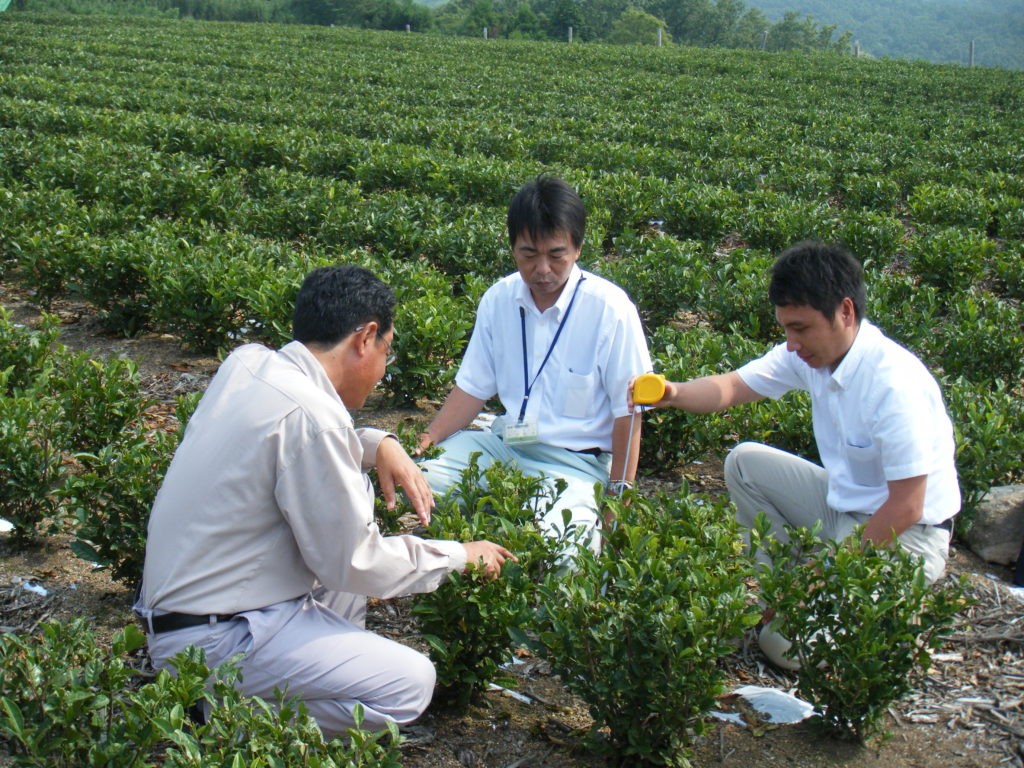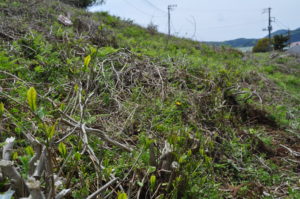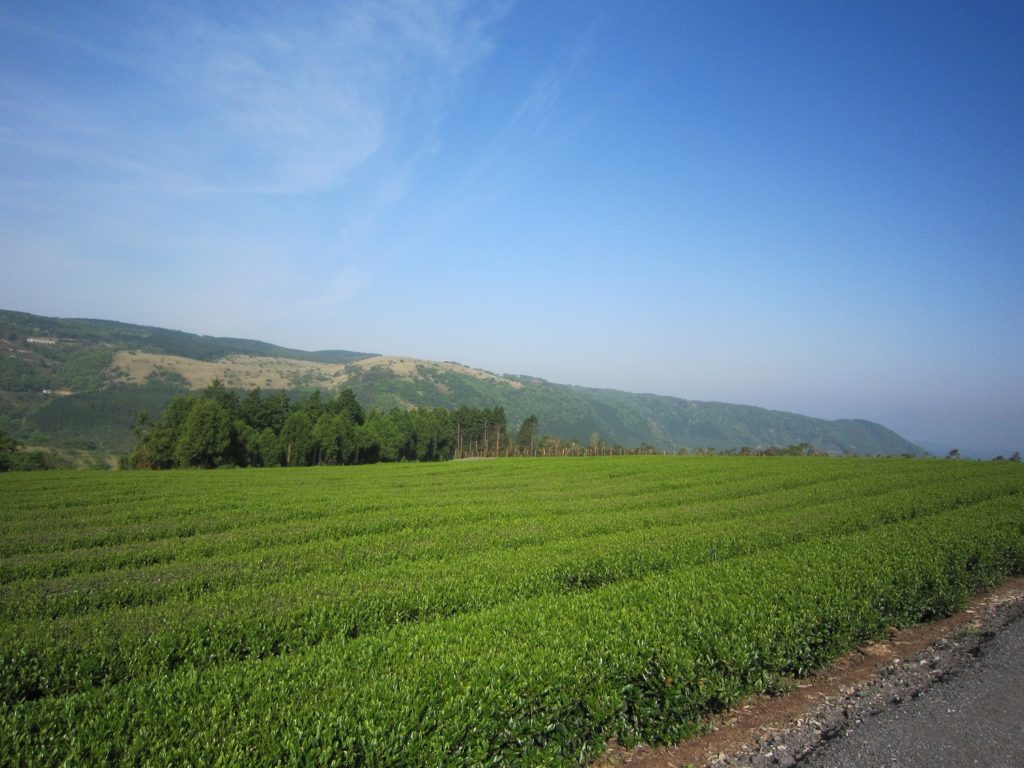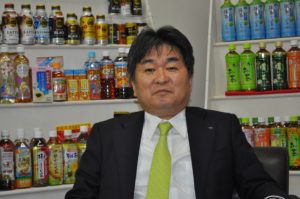
KITSUKI, Japan
Small family-owned tea gardens are inseparable from the economic and social past of historical places such as Kitsuki, a scenic coastal city and authentic samurai town, home to a castle that dates to 1394.
Tea permeates the culture here, having entered the fabric of Japanese society beginning in the 9th century. In the 1,000 years that followed, Japan’s tradition of passing land from generation to generation weathered times of upheaval, but tea was never abandoned.
In fact, tea emerged during these transitions revitalized. That is the hope once again for an industry challenged by a shortage of arable land and a retiring generation of aging tea growers.
![]() In 2016, ITO EN, the nation’s largest green tea purveyor and makers of Oi Ocha, Japan’s #1 selling green tea, was recognized by Fortune magazine as one of 50 Companies Changing the World. The company was praised for its Tea-Producing Region Development Project, to help restore some of Japan’s 400,000 hectares of abandoned farm land and to reconnect young people to the soil in places like Yamaga, a small town on the outskirts of Kitsuki.
In 2016, ITO EN, the nation’s largest green tea purveyor and makers of Oi Ocha, Japan’s #1 selling green tea, was recognized by Fortune magazine as one of 50 Companies Changing the World. The company was praised for its Tea-Producing Region Development Project, to help restore some of Japan’s 400,000 hectares of abandoned farm land and to reconnect young people to the soil in places like Yamaga, a small town on the outskirts of Kitsuki.
“The project is rooted in our passion and firm belief that preserving Japan’s green tea culture is important to all citizens of the planet,” writes ITO EN.
Tea is grown commercially in all seven prefectures of Kyushu, the southernmost island in Japan’s archipelago. Oita Prefecture is the smallest producer of the seven prefectures that grow tea but Oita is also one of the few places where growers are expanding cultivation to new and revitalized land.
ITO EN, a global supplier with $3.9 billion in sales and subsidiaries in the U.S., Australia, and Asia, worked closely with local farmers to create tea planting strategy and to purchase their entire production once harvesting began, providing security for the investment in the land.

Japan’s tea lands decreased from 150,000 acres (60,600 hectares) in 1985 to 108,000 acres (44,000 hectares) in 2015. Japan harvested 79,500 metric tons of green tea in 2015, the first time that production dipped below 80,000 metric tons in several decades. In 2016, yield increased to 80,200 metric tons but lands planted in tea continued to decline to 106,500 acres (43,100 hectares).
Rows of neatly pruned bushes cover rolling hills and surround hot springs outside the cities of Kitsuki, Usuki, and Usa. Like most of Japan, tea growers here export very little tea, preferring to scale their factories to the needs of nearby residents. Age is a concern. The prefecture ranks 13th, with 49% of the population older than 65 and only 13% under the age of 14.
“We as a company have a unique responsibility to ensure not only socio-economic stability for tea farmers, but environmental protection and sustainability for future generations,” writes ITO EN.
In the past decade, the average age of Japan’s tea farmers has increased to 66 years. There were 59,248 tea farmers in Japan in 1995 according to the Ministry of Agriculture,Forestry and Fisheries. Today that number has dropped by half. During the past 20 years, the number of farmers under the age of 60 has declined by 80%. Two thirds of Japan’s 3.12 million farmers are now older than 60, with 50% older than 65. In a typical town, fewer than half of the population makes its living at farming. A survey found that nearly one in three Japanese farmers are so disillusioned that they do not want their children to succeed them.
The future of the tea industry in Japan cannot be viewed optimistically.

Green giant
ITO EN realized some time ago the current situation threatens its supply and has taken measures to secure green tea procurement since the 1970s. The first pillar of the company’s Program for Revitalizing Tea-Growing Regions was strengthening ties with tea producers. ITO EN buys the entire production of contracted tea farmers, providing incentives that have increased producing areas on contract farms from 850 hectares in 2011 to 1,200 hectares, primarily in major tea-growing areas located in the southern half of the country. The company’s goal is to add 5,000 acres (2,000 hectares) of new tea production.
“We as a company have a unique responsibility to ensure not only socioeconomic stability for tea farmers, but environmental protection and sustainability for future generations,” writes ITO EN.
Finding suitable land is not easy. Japan has a severe shortage of arable land, only 11% is suitable for agriculture. The U.S. by comparison, with a population twice that of Japan, has 82 times more arable land. Japan’s Agricultural, Forestry and Fisheries Ministry believes the country needs 4.61 million hectares of cultivated land to achieve food self-sufficiency. Most farm land is devoted to growing rice, but rice paddies are not suitable for tea as the trees must be well drained. Hillsides are ideal for growing tea, but make it difficult to mechanize production.
Oita is one example where the trend has reversed. Growers expanded tea cultivation there by 100 hectares from the initial 345 hectares with a goal of adding 200 ha by 2019. ITO EN has been involved in the project since 2005 when it developed a 10-year plan with the prefectural government. In 2006, municipal governments in Kitsuki and Usuki joined the agreement and in 2012, Usa’s municipal government joined as well. One hundred hectares of new tea lands were allocated exclusively for production of raw material for ITO EN’s ready-to-drink (RTD) teas. Since that time, two hectares of abandoned mulberry trees have been converted by Kayano Nousan, a subsidiary of a construction company formed to develop new tea plantations. Employees look after the tea fields in spring and summer, then switch to construction work in autumn and winter, according to ITO EN.
Abandoned farms
Tea bushes take about five years to produce commercial quantities of leaves. Pruned aggressively they produce for 40 years. In their prime, tea gardens are easily expanded but once abandoned they present many challenges.
“Tea bushes grow so high without proper maintenance,” explains Masahiko Arai, General Manager of the Agricultural Technology Division at ITO EN. “A disused tea field after two years or more requires tremendous work to prune the bush and recover a productive dome shape. The effort is not economically effective,” he said.

“We prefer flat and expansive land with mild climate and abundant rainfall for our tea plantations,” Arai said. “Consequently, we have not found acceptable places except Kyushu to cultivate new tea plantations.” he said.
The increase of abandoned farm land is a serious issue not only for individual farmers but also the Japan Agricultural Cooperatives (JA) as well as central and local governments. Since ITO EN’s need for green tea is still growing, regional JAs and governmental bodies continue to approach the company seeking help in converting untended farm land to new tea plantations.
Developing new growing regions benefits ITO EN, as growers produce special varieties of green tea leaves suitable for its ready-to-drink line. Growers also learn new techniques and to operate modern harvesting equipment as ITO EN seeks to produce green tea at minimal cost. By year end 2016, the new tea plantations had expanded to 400 ha, and were operated by seven agricultural entities spread over six regions in the four prefectures of Kyushu Island.
The tea plantation project has become the second pillar of the ITO EN’s revitalization program.
Assisting aging farmers
In the Miyazaki Prefecture of Kyushu, an aging farmer without a successor was the first to ask the local JA to borrow farmlands previously used to raise vegetables and as pasture. The JA contacted ITO EN and agreed to establish a tea plantation of 100 ha over a period of five years. A new agricultural corporation was created to transform the farmland into tea plantations. The tea grown in Oita is used in making “Oi Ocha,” Japan’s leading green tea brand.
ITO EN has selected 10 tea cultivars suitable for making its RTD, out of nearly 100 that are registered cultivars. The Yabukita variety is the most popular and covers about 80% of the fields in Japan. It is one of many choices, but not necessarily the best for RTD.
Cultivars are classified as early-, medium-, and late-flush varieties. A few cultivars are chosen from each of the three groups and planted in an efficient layout. Plucking is done by sophisticated harvesting machines. The middle flush cultivars are harvested five to seven days after the early flush varieties are plucked. The late flush leaves are plucked after an additional five to seven days.
The tea is processed in relatively small factories operating over a longer period to minimize manufacturing costs. Machinery is specifically designed to process raw tea for use in making RTD teas. Several green tea factories are operating, with six planned by the end of 2017.
ITO EN, which invented the first canned green tea in 1984, sells both leaf and bottled teas (as well as coffee and other drinks) with bottled tea accounting for 90% of sales. These include Oi Ocha, Teas’ Tea & Matcha Love. The company said it is committed to expanding production in Japan as well as other Asian countries.

ITO EN intends to proceed cautiously, noting fluctuations in demand and supplies of green tea, as well as changing trends in the RTD market.
The new agricultural corporations in Kyushu have employed nearly 100 workers creating new job opportunities for graduating students from agricultural universities and high schools. ITO EN regards this project as a part of its Corporate Social Responsibility (CSR) mission.
“We are committed to preserving Japan’s green tea culture, ensuring its environmental protection and sustainability for the next generation,” says Rona Tison, Executive Vice President of Corporate Relations & PR.
“Through our community involvement, we hope to nurture young tea farmers,” says Tison. “It’s rewarding to know that we are able to stimulate the local economies, while ensuring a stable supply of green tea leaves to sustain our business for generations to come.”
—

Next: Japanese grandmother Elizabete Ume Shimada revives specialty tea in the Ribeira Valley near São Paulo, Brazil. “Obaatian” means “grandma” in Japanese and it’s also the name of the artisanal black tea the family has been producing in the backyard of their house since 2014.
See: Grandmother’s Tea
Learn more: www.obaatian.com.br/
Tea Market
Get More Value from Your Tea: BRU Maker One
+41794574278
Jacque's Organics
(647) 804-7263
Hi Yumi,
Keep up the good Work. It was nice and very informative writing on Tea.
Great! It help me know more about tea, tks.
Where are new articles?
The Tea Discovery issue is in layout. Posts are published every 10 days (scroll down to see the latest). The next print version will be available in July. Dan